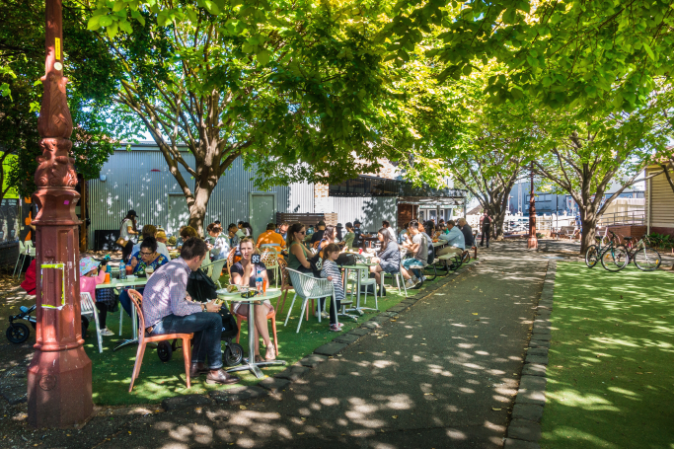Two of Australia’s suburbs – Melbourne’s Yarraville and Sydney’s Marrickville – recently ranked among the top 10 coolest neighbourhoods in the world. What are the x-factors that make a neighbourhood cool?
Two of Australia’s suburbs recently joined the cool cats of Barcelona, Paris, New York, Hong Kong and Los Angeles, according to Time Out.
The annual survey of the world’s coolest neighbourhoods unearths the greatest places for fun, food, culture and community. Yarraville got picked for its “epicurean edge and a perfect balance of residential and recreational”. Marrickville made the grade for its “surprising dualities”, where artisan bakers and stylish sommeliers “share the same curb as a no-frills Vietnamese sandwich shop”.

Time Out’s criteria are clear: the right mix of people, innovative and inclusive food, drink, arts and culture, affordable rents and living costs. But the coolest neighbourhoods also boast “that hard-to-define buzz”.
How do you define that buzz? We turned to some of Australia’s placemakers and cityshapers to unpack the x-factors of cool neighbourhoods.
- Effortless
“A cool neighbourhood is one that hits all the benchmarks of a great place, but the key factor is that it has evolved and settled into being without having to try,” says Colleen Peterson, a town planner and chief executive officer of Ratio Consulting.
The coolest neighbourhoods have a sense of “vibrancy and hype that is widespread and effortless,” Peterson adds. The cool factor is consistent, “offering layers of intrigue and novelty day and night, no matter the season”.
- Experimental
Bec McHenry, director of The Place Agency, is passionate about activating under-used and under-performing spaces. She says experimentation is an essential element of cool – but that experimentation requires a “low-risk testing ground”. “What’s cool right now is going to be stale bread in a few months. Cool neighbourhoods have businesses that dare to be different.”
Peter Vlitas, general manager for AVID Property Group in Victoria, agrees. “What was trendy last year might be seen to be uncool this year. If you’re unwilling to change with the times, you’ll become old-fashioned sooner than you know it. If you’re unwilling to explore boundaries and listen to what people want, you’ll find yourself losing that ‘cool’ factor.”
- Affordable
Hand-in-hand with experimental is affordability. “It’s no surprise that a lot of the trendiest new food venues tend to open off main-streets and in suburbs adjacent to the popular activity centres,” says McHenry. “Businesses with a novel idea tend to shun high rents and premium locations in favour of places that let them innovate.”
- Human-scale
For Dean Landy, a partner in urban design and mixed use with ClarkeHopkinsClarke Architects, the coolest suburbs are “compact, walkable, Instagramable places”.
“You don’t have to drive, you enjoy being there, and they lift your spirits. It’s the right blend of diverse uses, interesting little shopfronts, great foodie experiences, all at a human scale, with landscaping, intimate spaces and quirky art that brings them to life,” Landy enthuses.
- Multi-functional
Importantly, cool suburbs are not “single single-use, utilitarian places where you just go for your daily services,” Landy adds. They “have a big heart” with “housing density and diversity that accommodates a socio-economic cross-section of people and adds to the buzz”.
- Sticky
Another factor is what place-makers like to call ‘stickiness’. “Great neighbourhoods are like a long lunch – they are effortless to ease into and hard to leave,” explains McHenry. “In placemaking we call these ‘sticky’ places because they slow you down and encourage you to linger.”
Landy says Yarraville is deserving of its cool credentials because of its stickiness. “The renovation of the Sun Theatre and creation of the now-permanent pop-up park out the front transformed Yarraville into a go-to spot. It may have taken hard data to show traders removing cars wouldn’t mean losing customers, but it’s become a global exemplar of how quality, people-focused places actually attract more people – and those people linger longer.”
- Evolutionary
Vlitas has a few favourite neighbourhoods “and they all offer something different”, but he points to his own suburb of Carnegie and the transformation of a water holding facility as an example of how cool can creep up on us. After the local council converted it into a green space it has become a community meeting place that is “unique, innovative, adaptable and brings people together”.
“I would say that about 99 per cent of the time, especially on weekends, there are people of all ages using it. There are parents with young kids, teenagers playing basketball or tennis, there’s art across the back and some great sensory experiences throughout the space. They’ve even kept some of the elements of the history of the old Melbourne water basin which makes it distinct to its locality.”
- Proud
Cool neighbourhoods instill community pride. “Walking around a cool neighbourhood you can feel the pride that residents and business have for what they have created. Pride is a driving force that pushes places through their bad times and is often key factor in their revival and ongoing success,” McHenry says.
This local pride means the community “celebrates the greatness of its suburb unprovoked,” adds Peterson. “Of course, this means there are many people looking from the outside wishing they were a part of it”.
- Inclusive
Pride, overbalanced, can become exclusion. But the coolest suburbs are also the most inclusive places; Time Out tipped Sydney’s Marrickville for being a “true melting pot,” for example. Looking further afield to London, McHenry points to Camden Market’s slogan: “come in, we’re very open minded”.
“This quality of acceptance is an inherent personality of the coolest suburbs around the world. These are places where you can freely eat, drink and socialise and not feel judged; where you can travel from across the world to be there you don’t feel like an outsider; where it doesn’t matter how wealthy or well-dressed you are, you still feel acknowledged and appreciated.”
Source : First printed in Property Council Update.










